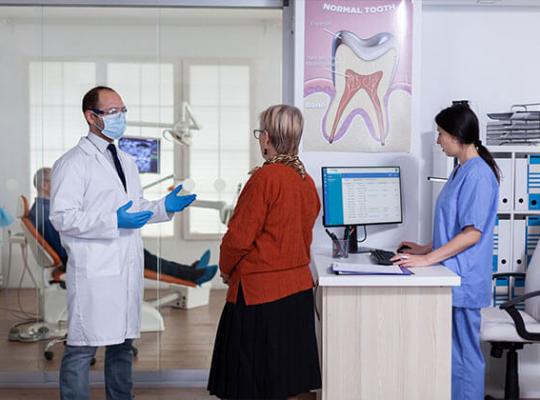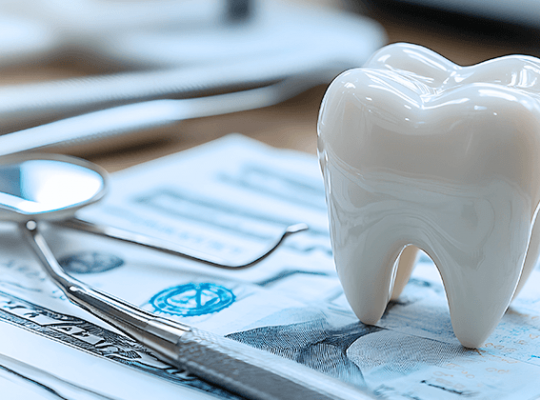Ends in
ends in 118 Days

ends in 118 Days

ends 11 July
The Ultimate Guide to Creating a Successful Dental Blog

If you looked up your dental competitors right now, how many have a blog? It's probably a good bet that nearly all of them do. And this is smart marketing on their part because patients want a source for trustworthy information, blogs drive traffic to the primary dental website, and search engine rankings will scale up as more content gets added.
So, how do you begin your own blog for your dental clinic? It starts with understanding the basic format first.
The Anatomy of a Dental Blog

There are specific elements you don't want to exclude from your own dental practice blog since they will play a key role in engaging your audience, converting leads into booked appointments, and contributing to your organic SEO strategy.
Below are some standard features you should include:
- Engaging media (photos, videos, infographics, and illustrations)
- A headline that grabs
- Informative introduction
- Smart segues into new information
- Clear main points with support
- A final summary
- A Call-to-action (CTA) link or button
Do's and Don'ts of Dental Blog Content Formatting

Quality content is of the utmost importance. Readers tend to know when they are reading a sales pitch or an article with little informative value. Avoid this by making sure any media you include is of high quality, adds to the message, and creates breaks between large content areas. Don't hesitate to peruse a few articles by other dental providers in your area to get a feel for what you want your blog' to look like.
While photos and videos are a great way to engage your potential patients' attention initially, you need to hold on to it by using intros that fuel their interest further into the message you want to convey. This section is usually ideal for sharing the primary focus of the article.
Even though you are also using your blog content as a search engine optimization boost, you must write with your viewership in mind. Use language they can easily understand, avoid overstuffing keywords and focus on the information you wish to share first. Google search crawlers view keyword saturation over 2% as borderline spammy, so aim for using these words and phrases once every 100-150 words or so.
Finally, the conclusion is your opportunity to summarize what was discussed, your dental practice's point of view on the topic, and a call-to-action (CTA). However, do not leave out that final push to book an appointment or call for more information. When readers reach the end of an article, they are more likely to follow the next steps you suggest.
Tips for Getting Started with Dental Blogging

If you're brimming with ideas for dental content you want to share, consider the following tips to ensure you present your topics effectively:
Discuss Pain Points in a Hopeful Tone
Most patients already associate discomfort and pain with going to the dentist, so avoid reinforcing this anxiety in your blog. When discussing certain oral health conditions or treatment options, it's okay to acknowledge discomfort from a cracked tooth or wisdom tooth extractions but focus on the relief your team provides the patient during these procedures.
Also, highlight how much better they will feel having their healthy smile back.
Presentation is Everything–Even in Blogging

When it comes to dental blogs or any industry blog, posts filled with large chunks of text, outdated screen formatting, and hard-to-read fonts don't fare very well. In fact, with the advent of social media platforms like Instagram and Pinterest, you communicate important information about your dental office with quality photos and videos.
This Utah practice reduced no-shows by 80% and saved 3 hours daily with Adit Are you still doing things manually in your dental practice? One Utah-based dental practice was overwhelmed by missed appointments, time-intensive forms, and inconsistent...
Schedule a DemoDefinitely think outside the box to get the most impact. Maybe an infographic with bright colors and crazy but true facts is more appropriate for what you're writing about. Whatever you share with the world about your dental practice, make sure your presentation is engaging and inspires visitors to share it.
Make HIPAA Compliance Your Top Priority
You will probably cover many universal dental care topics like how to floss effectively or recognize signs of gum disease. However, you want personalized content that reaches new patients on an individual level. Being able to share stories related to your audience's experiences is crucial, but you have to be careful.
HIPAA privacy laws require strict confidentiality of patient information. Just because you don't mention a name, age, gender, or other details doesn't mean you aren't violating someone's private medical information.
So, what can you do to remain compliant but still deliver relatable content?
Compile similar data into a single example. It's not uncommon for dental patients to deal with the same issues. You may have four or five you're currently treating for some form of periodontal disease. Instead of speaking on a particular case from a week ago, which could make the patient realize you're talking about them, talk about how you've experienced many instances of this problem for the two decades you've been a dentist.
Write a fictitious example. Similar to the core message of the periodontal example above, you can completely fictionalize your story. Instead of focusing on the number of cases you've treated, your central theme could be how preventable this condition is.
Talk about someone who doesn't exist or share similar health information with your new patients. Just express the sentiment that a solution is possible for sufferers.
Talk to the reader directly in the second person. A great example of HIPAA compliance in personalized content would be, "Do you know if your gums are healthy?" Then speak on the signs one might have if they have periodontitis and what to do about it.
Keep Your Marketing Strategy in Mind While You Write

Every blog post you share on your website needs to coordinate with your digital marketing strategy. Some straightforward ways you can optimize your content for search engines is to do the following:
- Keep titles and headers under ten words long
- Use meta descriptions and tags for the article and images
- Include a link to an authoritative source for some of your information
- Limit how many links you use to other service pages on your blogs (contact, services, other blog articles, etc.)
- Use keywords appropriately, and try not to overstuff your article
- Headers should be in a proper hierarchy
- Create an easy to remember permalink
- Alt text phrasing can boost on-page SEO by adding descriptions to your images on the backend for Google to recognize
There are several tools available for researching keywords and phrases for your content. Ahrefs is a popular web-based query tool that can help you narrow down what terms will best support your SEO efforts.
Cover Your Legal Liabilities
When you post a blog offering advice on caring for one's teeth or managing an ongoing condition like gum disease, you might find yourself liable for those sage words. Speak with an attorney before making treatment claims or diagnoses in your writings. When possible, use the most reliable sources available to support your statements.
You may want to consider including footnotes of your information resources. It's also recommended your blog have a brief disclaimer that is a shortcut to a more in-depth version.
Share Your New Blog Content Everywhere You Can
With your post complete, share it across every marketing channel available. You can even write up several articles at a time and schedule a date when they should get released to the public on your site and other platforms.
Social media sites like Facebook and your Google business profile pages are a high priority for this step since their viewerships are the highest worldwide. Don't forget to include a short 140-character or less description of your article in your postings, so users know what they are clicking to read.
Post Consistently
Creating engaging content that is SEO optimized takes practice. They always say that repetition is key to learning, which also goes for blogging. But, you need to do more than just regularly post– you need to do so predictably so your audience begins looking forward to your dental content.
The ideal release frequency for a dental blog post is at least a couple of times a month. This will ensure you maintain your site's momentum. In addition to how often you'll release new content, ensure search indexing will pick up your work easily by keeping blog lengths between 600 and 900 words.
As mentioned earlier, don't forget to add media to your blog post, break up large text areas, and try to stick to a 9th-grade reading level for your readers. Overly technical dental jargon can quickly shut down reader interest.
With a bit of effort and planning, you can create a blog for your dental office that your patients and prospects will rely on for important oral health information. This is one of the most cost-effective methods to create organic traffic to your business website.
It also can improve your overall Google ranking because you will grow your EAT factors with your authoritative content.
What Topics are Appropriate for a Dental Practice Blog?

Now that you know the basics of creating a blog, you need to determine which topics you want to focus your efforts on. Ideally, you already have a good idea of your dental practice's niche and can quickly list out some content topics based on those.
From there, you can break your entries down into a few different categories, including:
Dental Advice
You need to be careful of the type of advice you give, but topics around maintaining oral health are trendy and draw a lot of traffic. These entries will also further highlight your dental expertise, which will develop a level of trustworthiness with your readers.
Dental Care Guides
Everyone loves a good tutorial to explain how to do something. For example, providing a care guide on flossing or explaining the steps to clean dentures and bridges will be frequently visited. These articles are a great way to showcase some of your products for these purposes, too, so you can upsell more easily when patients come to your dental practice later.
Promotions for Dental Practices
Who doesn't like a great deal? These entries are typically shorter than your standard blog but contain many of the same elements. The primary purpose is to convert readers into booked appointments by offering some incentivization when they visit. For example, first-time patients might receive a free week's supply of home whitening paste.
Viral Health Topics
The exciting thing about trending oral healthcare news is it can be motivational, humorous, or downright wacky. Blogs that cover the latest in dental news should focus on stories that will grab and hold attention. Don't write about the ordinary; find the extraordinary. This can help you create a fan base addicted to your latest viral story reports.
Keep in mind, though, that these topics are often time-sensitive. Like fads, you either jump on board while they're in, or you'll sound odd bringing it up later.
Highlight Your Professional Accomplishments
Did you recently make the New Jersey Top 100 Best Dentists? Then that is certainly something worth blogging about. When you receive recognition for volunteer dental services you've donated in your local community or abroad, sharing this information in a blog post can make you more relatable to prospective and existing patients.
The same goes for any specialized training that broadens your scope of services at your dental practice. This isn't about bragging about how awesome you are. It's highlighting the fact you are the best dental provider available for patients in your area.
Listicles
Listicles is a fun word to say and comes from blending the two words list and article. These are extremely useful for creating a focused examination of important insights on your chosen topic. In the dental industry, practices often use this blogging style to cover top ten lists on a variety of subjects.
If it's international smile day coming up, you could create a blog post covering the top eight benefits of Teflon-coated floss.
Behind the Scenes Blog Post
Finally, consider writing a blog now and then highlighting what happens in your dental clinic on an average day. Behind-the-scenes stories help nurture your dental team's relationship with your patients and recognize the hard work they do to make appointments run smoothly.
Writing this type of piece also gives insight into what social atmosphere one can expect while receiving care at your dental practice. This can alleviate anxiety about treatment and break the ice ahead of time by giving them something to talk about with your team during their appointment.
Fine-Tune Your Blog's SEO Strategy with Adit

One of the biggest challenges dental practices face is having enough time in the day to get everything done. This includes finding time to craft quality blog content to share with your current and prospective patients.
If you aren't sure where to begin or if you have the time available to maintain a blog, you aren't alone. Adit assists dental offices just like yours to get the most out of their marketing efforts. Our team offers professional website design services that include a blog, social media share buttons, and content optimization so that your keywords are effective.
Our professional team of hand-picked content writers can assist you in creating value-added content your patients will benefit from reading. Don't have time to keep your blog updated? We have you covered! Adit can handle every aspect of your marketing strategy if needed, including posting relevant content every week based on your target audience's needs.
Contact us today to schedule a free demo and determine how our marketing services can create an SEO strategy for your dental blog that drives traffic and converts.
more about Adit?
Access a full suite of patient communication tools with Adit! Texting, payments, reviews, & scheduling in one place.
Schedule a DemoAfter spending 10 years helping dentists grow their practices, Ali witnessed the time and money dentists were wasting on outdated, fragmented technology that negatively impacted sustainable growth and the overall patient experience. So he developed Adit - a user-friendly SaaS platform that centralizes everything a practice needs to operate and simplifies the business of dentistry so doctors can get back to the medicine.
Get a $25 Gift Card when you take a demo
Schedule a Demo
Get a $50 Gift Card
when you take a demo
Looks like you're out of bounds!
Hey there! Your current location falls outside Adit's area of operation. If this is unexpected, try disabling your VPN and refresh your page. For further assistance or to book a live demo, connect with us at 832-225-8865.
December 29 Amazon Demo Promo
Terms and Conditions
Last Updated: December 29, 2025Offer ends January 1, 2026, and is limited to prospective customers who sign an annual agreement before December 31, 2025. Gift card will be emailed to the company owner or established representative within 4 weeks of signing the annual agreement. Offer may not be combined with any other offers and is limited to one (1) gift card per office. Offer is not available to current customers or to prospective customers or individuals that have participated in a Adit demo during the prior six (6) months. Recipient is responsible for all taxes and fees associated with receipt and/or use of the gift card as well as reporting the receipt of the gift card as required under applicable federal and state laws. Adit is not responsible for and will not replace the gift card if it is lost or damaged, is not used within any applicable timeframe, or is misused by the recipient. Adit is not responsible for any injury or damage to persons or property which may be caused, directly or indirectly, in whole or in part, from the recipient’s participation in the promotion or receipt or use of the gift card. Recipient agrees to indemnify, defend and hold harmless Adit from and against any and all claims, expenses, and liabilities (including reasonable attorney’s fees) arising out of or relating to a recipient’s participation in the promotion and/or recipient’s acceptance, use or misuse of the gift card. This offer is sponsored by Adit Communications, Inc. and is in no way sponsored, endorsed or administered by, or associated with Amazon.
Thank You!
We appreciate your interest! Adit AI will be calling you in the next few minutes!
Why Adit?
Cut your software bill by up to 60% when you merge everything your dental office needs to run under one roof.
Centralize Communications
- Phones & TeleMed
- Emails & eFax
- Texting & Reminders
- Call Tracking and more!
Streamline Operations
- Patient Forms
- Online Scheduling
- Payments
- Reviews and more!
Boost Production
- Performance Dashboards
- Morning Huddle
- Claims & Collections
- Patient Profiles
- Follow Up Lists
- Year Over Year Metrics
Acquire More Patients
- Digital Marketing
- Website Design
- SEO
- Google Ads
- Facebook Ads
Ends in

Sign up by filling out the form







